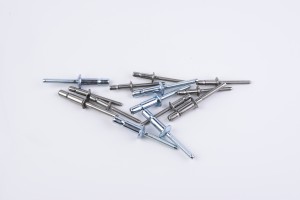The cup-shaped stainless steel rivet combines the advantages of many rivets. It has high tensile and shear resistance, sealing and shockproof functions. It has high riveting strength, wide riveting range and strong lock core ability. It provides a very powerful vibration joint connection and is suitable for For riveting situations with high requirements, good precision and poor working conditions, there are cup inner lock rivet wire drawing studs and cup outer lock rivet wire drawing rivets to choose from according to different riveting needs.
Cup rivet material The rivet consists of two parts: rivet tube and nail core. Using Hooke’s law, use a rivet gun to pull the nail core to form a force from the outside to the inside. The rivet tube is driven by the nail core. The rivet tube expands and the nail core presses against the hole to clamp the two workpieces that need to be connected to achieve riveting. The fastening part will not loosen and the workpiece will not separate. Select appropriate rivets according to the thickness of the plate that needs to be riveted and the diameter of the hole that needs to be riveted; choose according to the head type. Generally, round-head rivets are used in ordinary situations. If the surface of the workpiece needs to be flush and smooth, use countersunk-head rivets; according to the material of the workpiece Choose rivets made of different materials; aluminum rivets are often used in ordinary riveting situations; iron rivets can be used when higher riveting strength is required but acid and alkali resistance is not required; steel rivets are required when riveting strength is high and contain acid, alkali, etc. For corrosive substances, use stainless steel rivets
Types of cup pull nails In China, wire drawing rivets are also called
cup-type blind rivets, including internal locking wire drawing rivets and external locking wire drawing rivets. Drawn rivets, also known as cup-type blind rivets, are
structural blind rivets. After riveting, the broken part of the nail core will be flanged into the groove of the rivet body to lock the nail core. Internal locking brushed rivets and external locking brushed rivets have little difference from the surface, and their mechanical properties are roughly the same. The main reason is that the locking structure after riveting is different. Under normal conditions, internal locking brushed rivets can be used with a conventional rivet gun, and external locking brushed rivets can be used. Rivets need to be matched with a corresponding
rivet gun.
Main feature
1. High tensile and shear resistance; 2. Earthquake resistance; 3. Strong lock core ability; 4. The lock buckle is visible and easy to inspect; 5. Good sealing; 6. Provides very powerful vibration joint connection
2. Rivets have high riveting strength, high tensile and shear resistance, and an absolutely mechanically locked structure. Therefore, they hold much tighter than other types of rivets during riveting, and are waterproof and earthquake-resistant.
3. Cup countersunk head stainless steel rivets can be widely used in various fastening fields such as vehicles, ships, machinery manufacturing, electronic industry, instrumentation, food machinery, construction, and decoration engineering.
Instructions The method to detect the riveting effect is to use cross-sectional observation method and direct test method. Among the two methods, the cross-sectional observation method is the most intuitive, convenient and effective method. The so-called cross-sectional observation method is to split, grind and polish the rivet point along the meridian plane after riveting, and observe, measure and analyze its cross-sectional shape. The direct test method is the most reliable method to inspect riveting quality, but the operation is more complicated. Due to the lack of research on the relationship between joint cross-sectional shape and riveting quality, the current cross-sectional observation method still relies on experience, and the reliability of the results is not high. Therefore, there is still a need to conduct research on the occurrence of manufacturing defects in riveted joints, the evaluation of manufacturing defects, and the prevention of defects, etc., in order to provide a theoretical basis for the control and detection of riveting quality.

Post time: Jan-05-2024





